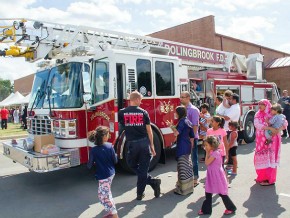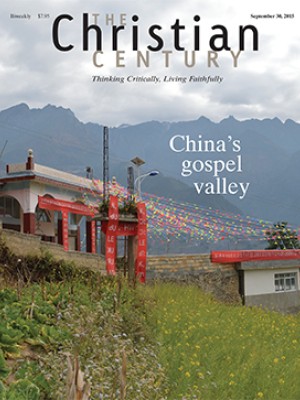The mosque next door: Getting to know our Muslim neighbors

Last spring our church paid a call on our neighbors at Masjid al-Jumu’ah, the new mosque in town. We live in Bolingbrook, a fast-growing suburb of 73,000 residents 30 miles southwest of Chicago. To the surprise of many of my city friends, a fifth of my neighbors out here in these cornfields-turned-subdivisions are African American, a quarter are Latino, and more than a tenth are of Asian descent. People here like to say, “Our block is like the United Nations!”
Diversity is not new in Bolingbrook, and Muslims are not a hidden population. Students in headscarves attend the high school; big-box grocery stores boast Middle Eastern and Indian aisles; a halal market does brisk business. For 25 years the mayor has enthusiastically participated in the annual Pakistan Independence Day celebration.
Read our latest issue or browse back issues.
But when Muslims purchased a foreclosed church building in Bolingbrook, a colleague told me that pastors in our local clergy association were concerned. One suggested that demonic forces were at work. I began to imagine protesters holding angry signs and writing inflamed letters to the editor.
Thankfully, nothing happened. Bolingbrook’s tolerance for difference prevailed. Then, in October 2014, the Muslim community received some unwelcome attention when a local Muslim teenager was arrested at O’Hare Airport: the 19-year-old and his two siblings were carrying tickets to Turkey and seemed to be on their way to Syria to join ISIS. The news coverage was explosive. His parents were shown on TV, his mother weeping in her hijab.
Dramatic incidents like this distract us from the fact that Islam is becoming a normal part of American suburban life. Yes, it’s true that some Muslim teenagers and young adults have been recruited online to join the terrorist organization that calls itself the Islamic State. It’s also true that Muslims have been killed in their own homes in Raleigh and Dallas, and that North American Muslim families and congregations are targeted for harassment and hate crimes even though most of them are living ordinary lives.
In the spring, two members of our church, St. Benedict, called up the leaders at Masjid al-Jumu’ah and asked if some Episcopalians could pay a visit. The leaders responded with warmth and excitement, and a month later 25 of us Episcopalians gathered in their parking lot. We wanted to be gracious visitors, so we women covered our hair with scarves and the men wore long pants.
The lobby looked like our narthex at St. Benedict. Tables and bulletin boards were covered with flyers advertising activities, volunteer opportunities, children’s programs, and a capital campaign. There was a large, shiny metal box with four slots marked: Suggestions, Zakah (tithed giving, one of Islam’s Five Pillars), Sadaqa (free offerings), and Masjid Donation (the building fund). Below the box were pledge postcards with the words “Charity Does Not Decrease Wealth.” One of my church leaders showed me the postcards, raising an eyebrow as if to say, “This is brilliant, and we’re stealing the idea.” She tucked the card in her purse.
We gathered in the gym, the men and women sitting separately. Three imams and a board member, Aamer, put on a program for us. Two imams wore traditional tunics and skullcaps. The Muslim women stood in the back of the room in their hijabs and long dresses.
My parishioners asked all kinds of questions. The Muslims were passionate (and understandably defensive) when asked about politically charged issues like the Bolingbrook teenager, images of Muhammad, and ISIS. When asked whether they had experienced harassment or vandalism, Aamer thought for a moment and shrugged. “Nothing major,” he said.
When someone asked why more Muslims don’t speak up against the radical few, one of the imams told us that when the shootings at Charlie Hebdo occurred, he was in Dallas and helped organize a vigil in response to the attack. He was delighted to see TV cameras arrive, and the crew filmed the peaceful, interfaith gathering for over two hours. But when the imam turned on the news that evening, the only coverage was of furious, anti-Muslim protesters. We could see the disappointment and humiliation on his face as he told us about the incident.
When we were invited to stay for lunch, a few of us exchanged eager glances—maybe we would be served homemade falafel, biryani, or curry? I hopefully sniffed the air. But then we saw women carrying pizza boxes. I was disappointed, but touched that our hosts served us with our tastes and culture in mind. We were confused when they didn’t join us, but perhaps the pizzeria was not halal.
After the program, one of the imams invited me to speak. I thanked the people for their warm hospitality, wished them a good Ramadan, and invited them to visit us at St. Benedict. I added that they probably knew a lot more about Christian culture than we did about Muslim culture, since they lived surrounded by Christian churches.
As we prepared to leave, a young woman came over in tears. “Thank you for what you said! That you would say, ‘You live surrounded by Christians’ and would wish us a good Ramadan is so kind!” I felt as if I’d won the Most Empathetic and Aware White Pastor of the Year Award. But I was sad that wishing someone “a good Ramadan” was such rare kindness from a Christian that it had moved this woman to tears.
Two months later we visited the congregation’s Eid al-Fitr festival, held at the end of Ramadan. It was a scorching hot day, and a woman in hijab was spraying sunscreen on her children’s arms. There were inflatable slides and bounce houses rented from a party company. Food tents offered samosas, chicken biryani, gyros pizza, Slurpees, and iced mocha lattes. Families and seniors sat under dining tents talking, while children ran around playing and adolescents clustered in groups. Three men helped our group find food, waving away our offers to pay for our meal tickets.
One of them, Ali, told me he’d read a blog post that I wrote when we were planning our first visit. I thought that on their website they had called their driveway “Biryani Drive,” which I said was great fun. When Ali told me that the website was actually referring to a biryani food drive, collecting pans of the rice dish for a fund-raiser, I laughed out loud.
An imam explained that the carnival was a way for the mosque’s children to see that Islam offers not only prayer and spiritual discipline, but also a way to have fun and to celebrate. He hoped the Eid carnival would help them not to feel left out when their neighbors are celebrating Christmas and Easter.
As a result of our visits, we now pray for our Muslim neighbors during the Prayers of the People, tag one another on Facebook, and look forward to more conversation, biryani, and pizza. We see—up close and locally—that diversity and community can mix in rich and expansive ways when we give one another the benefit of the doubt, and that too often, even or especially as members of a majority Christian community, we allow fear or awkwardness to keep us from meeting one another.
All it took was a phone call.






